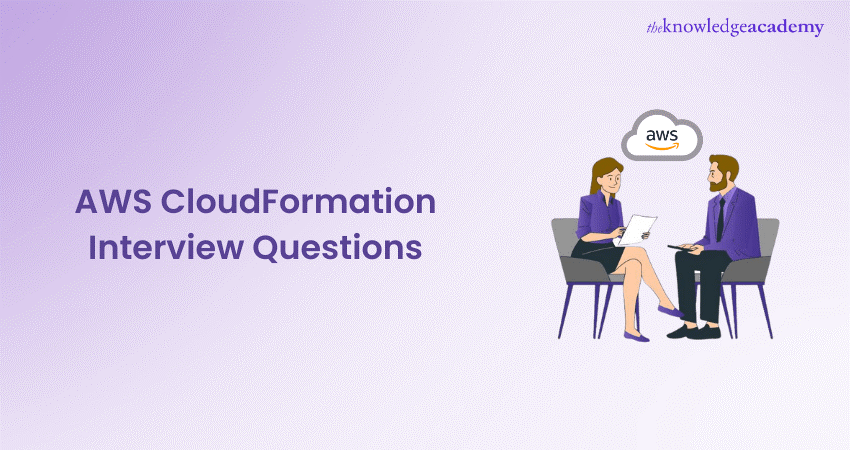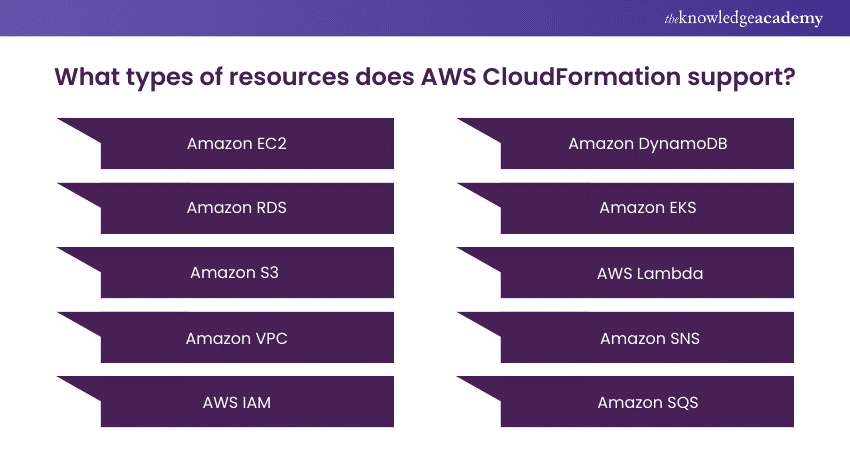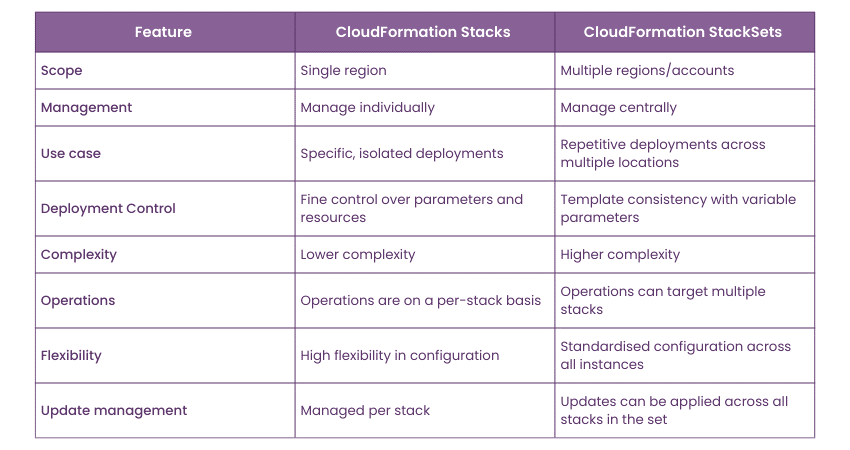We may not have the course you’re looking for. If you enquire or give us a call on 01344203999 and speak to our training experts, we may still be able to help with your training requirements.
Training Outcomes Within Your Budget!
We ensure quality, budget-alignment, and timely delivery by our expert instructors.

AWS CloudFormation is one of the core services in AWS infrastructure. This service enables professionals to build and manage cloud resources via automation. So, if you plan to become a successful AWS CloudFormation professional, having command over AWS CloudFormation Interview Questions covering CloudFormation topics and configuring AWS infrastructure is essential. The interview could include questions about how to make a template, inherent objects, managing resources, and problem-solving techniques.
Knowledge of these essential components is critical to any profile aiming to show off skills in high-level architectures, especially when they do this in a scalable, reliable deployment using AWS CloudFormation. Wait no further! Read this blog covering the frequently asked AWS CloudFormation Interview Questions and answers that will help you crack your following interview!
Table of Contents
1) Commonly asked AWS CloudFormation Interview Questions with answers
a) What is CloudFormation?
b) Can you explain what a template is in the context of AWS CloudFormation?
c) What are stacks?
d) How do you create a stack using CloudFormation?
e) How can you delete a stack that's already running on AWS CloudFormation?
f) What types of resources does AWS CloudFormation support?
g) How would you use AWS CloudFormation to configure an EC2 instance in a VPC environment?
h) Is it possible to run nested stacks using AWS CloudFormation? If yes, then how?
i) How can you update or edit a running stack without terminating it?
j) How do you define parameters while launching a stack using AWS CloudFormation?
2) Conclusion
Commonly asked AWS CloudFormation Interview Questions with answers
Let’s discuss some of the most asked AWS CloudFormation Interview Questions along with some sample answers:
1) What is CloudFormation?
This question evaluates if you have the proper knowledge of CloudFormation before the interviewer can ask you more in-depth questions.
You can answer this question using this: "AWS CloudFormation is a service that allows many developers and all types of businesses to create a collection of related AWS and third-party resources easily and provision them quickly and consistently. They also manage them throughout their lifecycles by treating infrastructure as code."
2) Can you explain what a template is in the context of AWS CloudFormation?
This question evaluates whether you know what is a template in AWS CloudFormation.
Here’s how you can answer this question: "A template in AWS CloudFormation is a JavaScript Object Notation (JSON) or YAML Ain’t Markup Language (YAML) formatted text file. It describes all types of AWS resources you need to deploy to run your application. It enables you to create and delete all the resources together as a single unit called a stack."
3) What are stacks?
This question aims to know if you know about the collection of AWS resources.
You can use this to answer your question: "In AWS CloudFormation, a stack can be defined as a collection of AWS resources you manage as a single unit; when you create a template and use it to instantiate a stack, CloudFormation provisions the specified resources defined in the template."
4) How do you create a stack using CloudFormation?
This question will measure how you can create a stack using CloudFormation.
You can use this sample answer for this question: "To create a stack in CloudFormation, you need to define a template and then use the CloudFormation console, AWS Command Line Interface (AWS CLI), or APIs to create a stack based on this template. You'll specify parameters and configuration options, which CloudFormation uses to provision and configure the resources."
5) How can you delete a stack that's already running on AWS CloudFormation?
This question gauges your understanding of how to delete a stack on AWS CloudFormation that has been running previously.
Use this sample answer for your question: "To delete a stack on AWS CloudFormation, you can use the CloudFormation console, CLI, or API to issue a delete command. CloudFormation then automatically deletes all the resources in the stack without deleting each individually, ensuring clean and error-free resource removal."
6) What types of resources does AWS CloudFormation support?
This question is asked in an interview to assess your knowledge of the different types of resources available on AWS CloudFormation.

You can answer this question: "AWS CloudFormation supports many AWS resources, such as Elastic Compute Cloud (EC2) instances, Simple Storage Service (S3) buckets and RDS databases. It can also support Virtual Private Clouds (VPCs), Route 53 domains, Identity and Access Management (IAM) roles, and many more. Most services available in AWS can be provisioned and managed using CloudFormation templates."
7) How would you use AWS CloudFormation to configure an EC2 instance in a VPC environment?
With this question, the interviewer wants to know if you can use AWS CloudFormation to configure an EC2 instance.
You can use this as your sample answer: "To configure an EC2 instance in a VPC using CloudFormation, you would define resources such as the VPC, subnets, security groups, and the EC2 instance itself in your CloudFormation template. You can specify properties such as the VPC ID and subnet ID for the EC2 instance, ensuring it's launched within the designated VPC environment."
8) Is it possible to run nested stacks using AWS CloudFormation? If yes, then how?
This question helps the interviewer understand whether you know why or how to run nested stacks using AWS CloudFormation.
Use this sample answer: "Yes, AWS CloudFormation supports nested stacks created as part of other stacks. You use a special resource type called 'AWS::CloudFormation::Stack' to define a nested stack within a template. This approach helps manage complex architectures by breaking them into smaller, more manageable components."
9) How can you update or edit a running stack without terminating it?
This question aims to understand if you can update or edit a running stack without terminating it.
You can use the following answer: “To update a running stack, I will modify the stack’s template or parameters and then submit the changes to CloudFormation, which performs an update operation. CloudFormation only updates the changed resources rather than rebuilding the entire stack, allowing seamless updates and configuration changes.”
10) How do you define parameters while launching a stack using AWS CloudFormation?
With this question, the interviewer wants to know if you can define parameters while launching a stack using AWS CloudFormation.
You can use this sample answer: “When launching a stack, you define parameters in the CloudFormation template to accept input values that customise how the stack is built. When creating the stack through the CloudFormation console, CLI, or API, you specify these parameters, providing the values that suit your deployment needs.”
Are you interested in mastering Elastic Compute Cloud with AWS? Then register now for our AWS Associate Solutions Architect Training!
11) How can you use AWS CloudFormation to manage your infrastructure?
This question will help the interviewer understand how to use AWS CloudFormation to manage the infrastructure.
You can use this answer in the interview: “AWS CloudFormation is a service that enables me to provision and manage AWS infrastructure resources using code. I can define your infrastructure in a CloudFormation template, which is a JSON or YAML file, and CloudFormation handles the provisioning and management of the resources specified in the template.”
12) What is the difference between individual CloudFormation Stacks and CloudFormation StackSets?
This question will help the interviewer understand if you know the difference between individual CloudFormation Stacks and StackSets.
You can use this as your sample answer: “Individual CloudFormation Stacks are used to provision resources in a single AWS account and region, while StackSets allow you to provision resources across multiple AWS accounts and regions simultaneously. StackSets provide a centralised way to manage infrastructure at scale.”
The table will help you understand better:

13) How does CloudFormation handle rollbacks in the case of a failed deployment?
This question aims to determine whether you have in-depth knowledge about CloudFormation and whether there has been any failed deployment.
You can use this sample answer: “CloudFormation performs automatic rollback when a deployment fails by reverting the stack to its previous known state. It does this by rolling back changes made during the deployment, ensuring the stack remains consistent and operational.”
14) Can you deploy functions without servers and then apply the management of resources via CloudFormation?
By asking this question, the interviewer plans to find out whether you can deploy serverless applications and resource management skills or not.
You can use this answer: “Sure, CloudFormation supports deploying serverless applications and manages resources such as AWS Lambda functions, API Gateways, DynamoDB tables, and more. After defining these resources in a CloudFormation template and then deploying them as a part of your stack of serverless applications.”
15) What would be the use of this technique CloudFormation for blue/green deployment?
You can answer this question in this manner: The blue/green deployment can be done in CloudFormation by building two separate stacks: the current production environment (blue stack) and the updated version (green stack). With the approved production green stack deployer ready, a DNS / load balancer swap can be done to route traffic to the updated version.
16) What exactly would the role of CloudFormation be together with CDK?
This question serves to identify whether you know how AWS CDK ties with CloudFormation or not.
You can use this as your answer: “The AWS Cloud Development Kit (CDK) is a roof over CloudFormation which offers developers the ability to define infrastructure by using more understandable ways like TypeScript, Python, and Java.” CDK code is reorganised into CloudFormation models and deployed using the CloudFormation function.
Register now for our AWS RoboMaker Training to enhance your knowledge of developing and deploying a robotic application!
17) What exactly is the association link between the AWS SAM and AWS CDK?
You can use this as your sample answer: "AWS Serverless Application Model (SAM) is an open-source template for building serverless applications. While AWS CDK and AWS SAM are available, AWS CDK provides further infrastructure resources and more programming languages for serverless applications."
18) Can AWS SAM CLI test the Lambda function locally defined with AWS CDK?
This question explores your knowledge of AWS and how you can use it in your repertoire.
This sample answer can help you answer this question: “The AWS SAM CLI supports local Lambda function testing defined by AWS CDK. You can use the SAM local invoke command to invoke Lambda functions locally and test their behaviour before deploying them to AWS.”
19) Under what license is AWS CDK distributed?
You can use this sample answer for this question: “AWS CDK is distributed under the Apache License 2.0, which allows users to use, change, and distribute the software freely, subject to certain conditions and limitations outlined in the license.”
20) How much does AWS CDK cost?
You can utilise this answer: “AWS CDK is free to use. However, you may incur charges for the AWS resources provisioned and managed by CloudFormation when deploying CDK stacks. The cost depends on the types and quantities of resources provisioned in your infrastructure.”
Become an AWS professional with our AWS Certification Courses – sign up now!
Conclusion
We hope you read and understand the AWS CloudFormation Interview Questions discussed in this blog. Understanding these commonly asked Interview Questions equips candidates with the knowledge to navigate interviews confidently. Additionally, it helps demonstrate their proficiency in automating infrastructure deployment and management on AWS.
Learn the fundamental principles of AWS CloudFormation with our AWS CloudFormation Training!
Frequently Asked Questions
Upcoming IT Security & Data Protection Resources Batches & Dates
Date
 AWS CloudFormation Training
AWS CloudFormation Training
Fri 19th Jul 2024
Fri 18th Oct 2024







 Top Rated Course
Top Rated Course



 If you wish to make any changes to your course, please
If you wish to make any changes to your course, please


